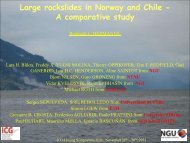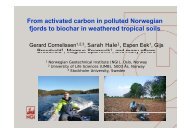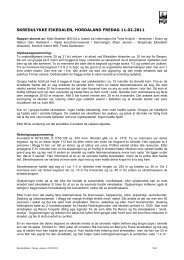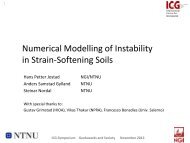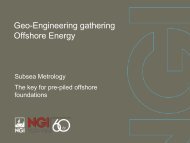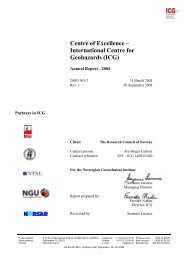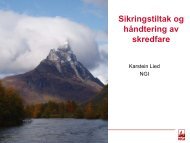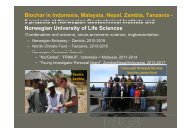AEM for rockslides & tunneling hazards.pdf - NGI
AEM for rockslides & tunneling hazards.pdf - NGI
AEM for rockslides & tunneling hazards.pdf - NGI
You also want an ePaper? Increase the reach of your titles
YUMPU automatically turns print PDFs into web optimized ePapers that Google loves.
SPECIAL S h a l l SECTION: o w h a Sz ha al r ld ol w so hw a zha ra dz sa r d s<br />
Airborne EM mapping of <strong>rockslides</strong> and <strong>tunneling</strong> <strong>hazards</strong><br />
A. A. Pfaffhuber, E. Grimstad, and U. Domaas, Norwegian Geotechnical Institute<br />
E. Auken and N. Foged, University of Århus<br />
M. Halkjær, SkyTEM ApS<br />
We have investigated potential <strong>rockslides</strong> in Western<br />
Norway using a time- and cost-efficient airborne<br />
electromagnetic (<strong>AEM</strong>) survey approach. The study area<br />
comprises phyllite, a low-grade metamorphic rock type that<br />
tends to be reworked to clay in disturbed zones. Mapping<br />
these electrically conductive clay zones was the aim of the<br />
<strong>AEM</strong> survey. Based on indications that precipitation drives<br />
the reported rockslide movements, the local municipality<br />
and regional hydroelectricity company are evaluating the<br />
option of draining the unstable area to a nearby hydropower<br />
reservoir using a drainage tunnel of more than 10 km. We<br />
conducted the <strong>AEM</strong> mapping survey to locate the sliding<br />
planes and to investigate the tunnel corridor <strong>for</strong> areas with<br />
potential <strong>tunneling</strong> <strong>hazards</strong>. Spatially constrained inversion<br />
of the data set (250 km) reveals extended conductive zones<br />
interpreted as sliding planes and/or gneiss/phyllite interface.<br />
Detailed follow-up of these initial results is planned with<br />
targeted percussion drilling and ground resistivity surveys.<br />
Introduction<br />
The inner Aurland Fjord with the adjacent Flåm Valley (in<br />
western Norway) are among Norway’s most famous tourist<br />
destinations with up to 450,000 visitors and more than 100<br />
cruise ships a year visiting the area. The main road between<br />
Oslo and Bergen (E16) passes through Flåm, bypasses the<br />
fjord, and enters the 24.5 km Lærdalstunnelen in Aurlandsvangen.<br />
Evidence of large <strong>rockslides</strong> in the geological past<br />
has been documented in the area with ground movements<br />
evident to the present day. The area is subject to potential<br />
<strong>rockslides</strong> composed of creeping rock and debris masses (Figure<br />
1). The intent of our study was to provide geophysical<br />
input to the ongoing natural hazard assessment program in<br />
Aurland municipality.<br />
Based on repeat GPS measurements and anecdotal observations<br />
in the area, rock and debris movements are influenced<br />
by precipitation and snow melt. Based on this empirical<br />
evidence, the local municipality and regional hydroelectric<br />
company E-CO Vannkraft are evaluating the potential of<br />
draining the unstable area to a nearby hydropower reservoir<br />
(Viddalsmagasinet) with the aid of a 10-km tunnel. Initial<br />
interpretations of an airborne electromagnetic (<strong>AEM</strong>) mapping<br />
survey conducted in June 2009 reveal indications of the<br />
sliding planes and assess the tunnel corridor <strong>for</strong> potential <strong>tunneling</strong><br />
hazard areas.<br />
The investigated area consists of a basement of highgrade<br />
Precambrian metamorphic gneisses overlain by a nappe<br />
(sheet) of phyllite with another layer of high-grade metamorphic<br />
gneisses with minor layers of quartzite and other<br />
rock types resting on the phyllite layer. During the <strong>for</strong>mation<br />
of the nappe, the weaker phyllite acted as lubrication<br />
in the thrust zone between the basement of the Precambrian<br />
Figure 1. Study area (aerial photography draped over topographic<br />
model courtesy of www.norgei3d.no) indicating areas with known<br />
previous <strong>rockslides</strong> and creeping movements (orange arrows) of both<br />
massive rock (fjord) and loose debris (valley) partly driven by pore<br />
water delivered by the Stampa and Gudmedalen catchments. Red lines<br />
indicate the potential water drainage tunnel system.<br />
Figure 2. Fundamentals of <strong>AEM</strong>. A helicopter-towed wire loop<br />
induces electrical eddy currents in conductive ground, inducing a<br />
secondary magnetic field picked up by receiver coils. Background photo<br />
shows the escarpment in area C sliding downhill at 1–3 cm per year.<br />
gneisses and the overlaying gneisses. Normally the thrust zone<br />
recrystallizes to a schistose layer, during postmovement lowgrade<br />
metamorphism.<br />
<strong>AEM</strong> survey<br />
Unstable rock in the study area, some 1000 m above sea<br />
level, has been mapped as massive phyllite broken by numerous<br />
tension cracks with openings up to several meters. Field<br />
observations also document significant amounts of surface<br />
water in streams on the mountain plateau around Joasete<br />
936 The Leading Edge August 2010
S h a l l o w h a z a r d s<br />
Figure 3. Spatially constrained inversion (SCI) result. Interval resistivity averaged 40–50 m (left panel) and 100–110 m (right panel) below<br />
ground (depth slice) mapped over survey area. Purple and green lines roughly outline mapped weakness zones and phyllite/gneiss interface,<br />
respectively. Bright blue areas are areas where minimal <strong>AEM</strong> signal was recorded due to highly resistive ground.<br />
(Figure 1) that disappears into some of these cracks and reappears<br />
on the surface several hundred meters down the slope.<br />
Potentially sliding planes provide pathways <strong>for</strong> the water<br />
with changes in water pressure potentially causing instability.<br />
Because the phyllite can be crushed to fine-grained clay<br />
under certain conditions, the water-saturated sliding planes<br />
should be an ideal target <strong>for</strong> <strong>AEM</strong> because they are conductive<br />
(1–10 Ω∙m) compared to the more resistive, undisturbed<br />
phyllite or nearby gneiss (> 1000 Ω∙m). Earlier ground resistivity<br />
measurements in the area strengthen this hypothesis.<br />
Note that these geological conditions are in strong contrast<br />
to other Norwegian <strong>rockslides</strong>, like Åknes, which is within a<br />
gneiss where resistivities of several thousands (up to 10000)<br />
Ω∙m are possible even in the water-saturated zones (Heincke<br />
et al., 2010).<br />
The <strong>AEM</strong> survey was carried out with SkyTEM, a helicopter-borne,<br />
time-domain EM system (Figure 2; Sørensen<br />
and Auken, 2004). Approximately 250 line km where flown<br />
at 125-m line spacing with some infill lines in the central<br />
part of the survey area. To improve lateral resolution in this<br />
area of large topographic relief, flight speed was a nominal 7<br />
m/s at 30 m above ground (sensor height). The system was<br />
operating with two relatively low transmitter moments tuned<br />
specifically <strong>for</strong> high-resolution near-surface mapping: 63 kA<br />
m 2 and 2.5 kA m 2 at 100 Hz and 200 Hz base frequencies,<br />
respectively, with a 60% duty cycle. This setup led to offtime<br />
windows from 8.4 µs to 2.5 ms. Standard processing and<br />
spatially constrained inversion, SCI (Viezzoli et al., 2008),<br />
generated resistivity maps and profiles. Only the vertical magnetic<br />
field component (Hz) was considered <strong>for</strong> inversion. Because<br />
SkyTEM also acquires the horizontal field component<br />
(Hx), future analysis and interpretations could include 3D<br />
data components.<br />
Results<br />
Our preliminary <strong>AEM</strong> data interpretation found widespread<br />
areas with high conductivity, most likely caused by either<br />
water-saturated, fine-grained sliding planes or fault zones at<br />
the phyllite/gneiss interface (Figure 3). Based on our initial<br />
survey concept, we expected limited signals from phyllite that<br />
had been reworked to clay but no significant response from<br />
the undisturbed phyllite and gneiss environments. Much to<br />
our surprise, we found strong and consistent signals covering<br />
nearly the entire survey area (Figure 3). In the following, we<br />
highlight some examples; however, we are only beginning to<br />
understand the subtleties of the processed data:<br />
• Some flight lines where extended over the fjord to test the<br />
bathymetry-sounding capability of the TEM system. Because<br />
the fjord is filled with old debris, the water column<br />
August 2010 The Leading Edge 937
S h a l l o w h a z a r d s<br />
Figure 4. 3D visualization of area C around Joasete (Figure 3) looking south. A slightly transparent aerial photo is draped over topography with<br />
no vertical exaggeration. The 70–80 m resistivity depth slice draped 75 m below the topography shines through the aerial photo. An exemplary<br />
conductivity depth section derived from SCI results represents a cross section at the profile indicated with a green, stippled line.<br />
was expected to be shallow enough (< 50 m) <strong>for</strong> complete<br />
signal penetration. The high conductivity of the sea water<br />
is evident in the shallow (40–50 m) resistivity map (Figure<br />
3, left), while the deep (100–110 m) depth slice probes<br />
the seafloor (Figure 4, right). The conductivity depth section<br />
from multilayer, smooth inversion (Figure 4) shows<br />
the limited thickness of the conductor (sea water). Further,<br />
four-layer inversion (not shown) indicates water depths<br />
between 40 and 60 m, which is in remarkably good agreement<br />
with bathymetric charts indicating depth ranges<br />
from 43 to 59 m in the area.<br />
• A meandering distinct conductor close to Viddalsdammen<br />
roughly coincides with the phyllite/gneiss boundary<br />
known from surface mapping (Area A, Figure 3). Following<br />
the feature through different depth slices indicates a<br />
fairly flat dip to the southwest (Figure 5).<br />
• Consistent from line-to-line, and covering a large area<br />
(some 10 × 2 km) 10–80 m below the surface, is a massive<br />
conductor that expands to a thickness of up to 100<br />
m (Area B, Figure 3 and Figure 4). Given the inductive<br />
nature of the <strong>AEM</strong> measurements, the depth to the base of<br />
the conductor can only be roughly estimated. The data indicate<br />
clearly, however, that a resistor underlies that structure.<br />
Generally the conductor dips con<strong>for</strong>m to the topography.<br />
The lateral extent of this feature frequently co-aligns<br />
with topographic or geological features (Figure 3).<br />
• The subsurface around Joasete but also along the slopes<br />
down to Aurlandsfjorden and Flåmsdalen features widespread<br />
conductive anomalies (Figure 4). The debris-covered<br />
slopes usually feature consistent, thin conductors<br />
while the anomalies at Joaste and Stampa (Area C, Figure<br />
3) are more complex, most likely caused by subvertical 3D<br />
structures.<br />
Discussion<br />
Even though we have gained significantly more in<strong>for</strong>mation<br />
about the area’s geology from the <strong>AEM</strong> survey, care has to<br />
be taken when interpreting the measurements. Even though<br />
SkyTEM is a versatile system <strong>for</strong> rough topography (slow<br />
flight speed, acquisition of system altitude and attitude with<br />
lasers and inclinometers), the SCI algorithm has been designed<br />
<strong>for</strong> efficient mapping of layered structures with limited<br />
topography both on the surface and the geology. Here<br />
we are faced with a high relief (up to 80%) and evidence<br />
of strong 2D and 3D contrasts that exceed the assumptions<br />
and approximations which apply to SCI processing. Hence,<br />
detailed follow-up of 3D artifacts in the results involving the<br />
acquired Hx component is crucial be<strong>for</strong>e final decisions are<br />
made.<br />
Conclusions<br />
Based on the geophysical data and knowledge from geological<br />
pre-investigations, we can draw the following preliminary<br />
conclusions:<br />
• The known, outcropping phyllite/gneiss interface close to<br />
938 The Leading Edge August 2010
S h a l l o w h a z a r d s<br />
Figure 5. Area A adjacent to Viddalsdammen (Figure 3) looking NNW. The 30–40 m resistivity depth slice is draped 35 m below the<br />
topography. For a more detailed description refer to Figure 4.<br />
Viddalsdammen (Area A, Figure 3 and Figure 5) appears<br />
as a strong conductor dipping southwest, consistent with<br />
outcrop data. This indicates the presence of crushed phyllite<br />
(potentially with graphite infill), thereby representing<br />
a <strong>for</strong>merly unknown potential <strong>tunneling</strong> hazard.<br />
• A similar feature appears over large areas on the west flank<br />
of the mountain plateau (Area B, Figure 3 and Figure 4),<br />
which may indicate a thin, 50–150 m layer of phyllite<br />
overlaying gneiss.<br />
• More complicated anomalies appear around Joasete (Area<br />
C, Figure 3), potentially indicative of the anticipated sliding<br />
plane response. Further down the slope a consistent,<br />
conductive layer most likely indicative of the base of a debris<br />
field filled with fines and thus the sliding plane <strong>for</strong> the<br />
creeping debris along the fjord and valley.<br />
No final conclusions can be drawn from geophysical data<br />
alone, however. At this point, only limited drilling is necessary<br />
to trans<strong>for</strong>m the geophysical maps to a firm geological<br />
model. We are planning a ground follow-up survey with electrical<br />
resistivity tomography to gain 2D or 3D in<strong>for</strong>mation<br />
on the structures. The intent is to further distinguish clay<br />
from phyllite containing graphite by virtue of the induced<br />
polarization response.<br />
Acknowledgments: We acknowledge Bjørn Sture Rosenvold (Aurland<br />
municipality) <strong>for</strong> initiating this investigation and partial<br />
funding. We thank Rasmus Teilman (SkyTEM ApS) <strong>for</strong> excellent<br />
work during <strong>AEM</strong> data acquisition. AAP and EG received<br />
funding from the Norwegian Research Foundation through KMB<br />
project 182728. Some material in this article will be presented at<br />
EAGE's Near-Surface Conference.<br />
Corresponding author: Andreas.A.Pfaffhuber@ngi.no<br />
References<br />
Heincke, B., T. Günther, E. Dalsegg, J. S. Rønning, G. V. Ganerod,<br />
and H. Elvebakk, 2010, Combined three-dimensional electric<br />
and seismic tomography study on the Åknes rockslide in western<br />
Norway: Journal of Applied Geophysics, 70, no. 4, 292–306. doi:<br />
10.1016/j.jappgeo.2009.12.004.<br />
Sørensen, K. I. and E. Auken, 2004, SkyTEM–A new high-resolution<br />
helicopter transient electromagnetic system: Exploration Geophysics,<br />
35, 191–199.<br />
Viezzoli, A., A. V. Christiansen, E. Auken, and K. I. Sørensen, 2008,<br />
Quasi-3D modeling of airborne TEM data by spatially constrained<br />
inversion. Geophysics: 73, no. 3, F105–F113.<br />
August 2010 The Leading Edge 939





